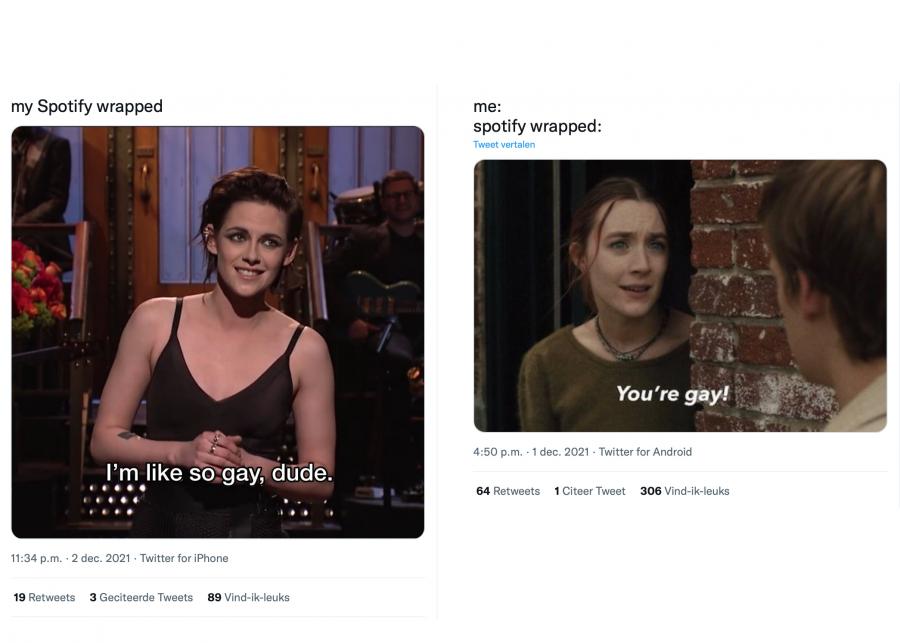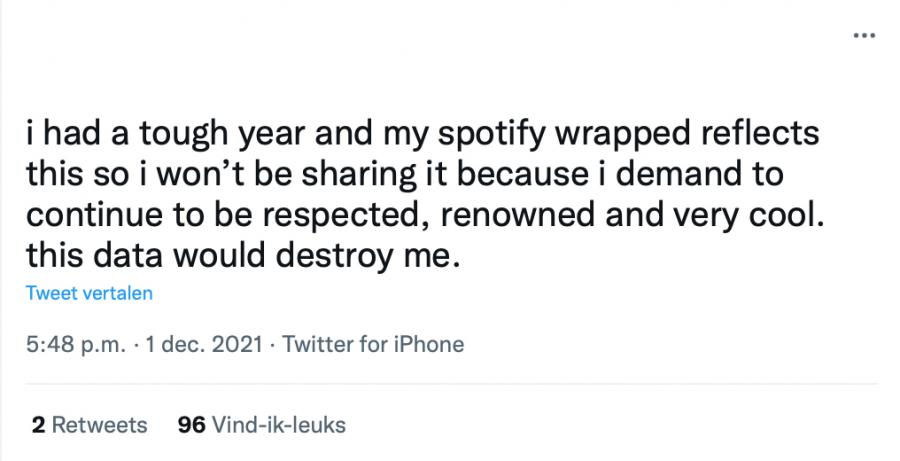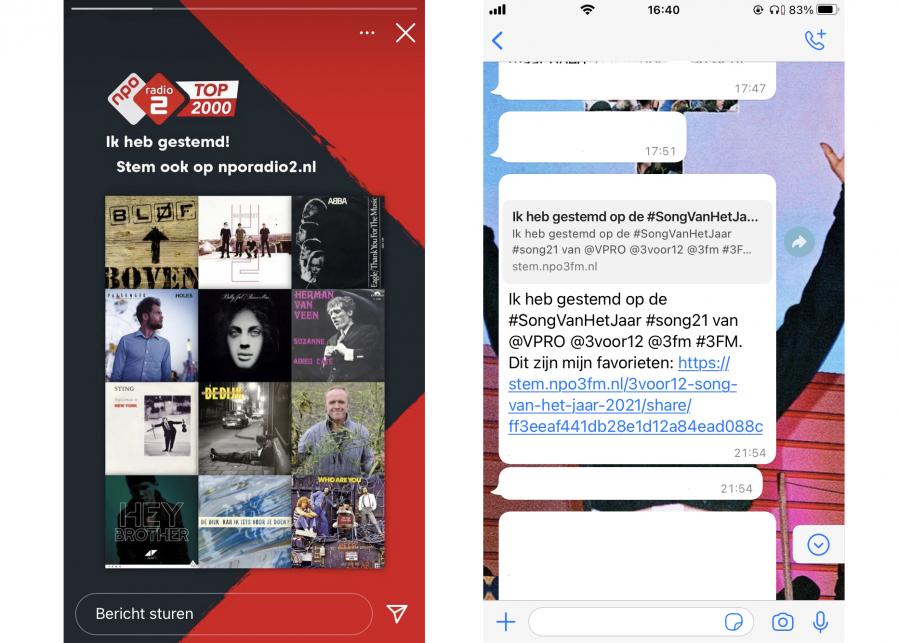
What does your Spotify Wrapped say about you?
Spotify Wrapped has quickly become a widespread holiday tradition. We love to look back at our ‘year in music’ and share the recap with others via social media. The reason might seem simple: it’s fun. But what if there’s more to it than just fun? What if the Spotify Wrapped tradition tells us something about contemporary online culture, about the influence of tech companies, and - ultimately - about ourselves?
Music and identity
Music has always been an important part of our identity. But now that the musically focussed subcultures like the punkers, gabbers and gothics have largely dissipated, we are partly at the mercy of technological algorithms - like the one behind Spotify Wrapped - to express our identity through music.
When I asked my Instagram followers if they felt their Spotify Wrapped said something about their identity, 70% answered ‘Yes’. But when I asked if their Wrapped was a good representation of their identity, only 46% agreed (n=39). How can this be? For the answer, we need to take a step back and actually look at how we form our identities in contemporary (online) culture.
Culture as accent
To some degree, we all want to fit in. In society at large and in our own, smaller social groups. We follow fashion trends, social trends, food trends, music trends, etc. I’m generalizing, of course. That’s because I’m talking about the bigger picture. When I say we follow fashion trends, I mean that you don’t see too many people wearing 19th century dresses anymore. And when I say we follow music trends, I mean that you don’t hear that many religious hymns on mainstream radio nowadays. In that sense, our social world has become very uniform.
In their essay bundle 'Enoughness, accent and light communities: Essays on contemporary identities' (TPCS 139), Jan Blommaert and Piia Varis (2015) explain that it is in this very uniform world that “small differences acquire the status of fundamental aspects of being.” Because we all want to fit in, we have to base the uniqueness of our social identity on a carefully curated collection of very small details that make up ‘who we really are’. We express these details with e.g. the clothes we wear, the car we drive, the food we eat, and the brand of phone we use. Blommaert and Varis call this ‘culture as accent’.
Everything you do online can function as a small detail that says something about your identity.
Even the smallest detail, like the brand of beer you prefer, can project a great host of ideas about your identity. You can be a ‘Heineken person’, a ‘Guiness person’ or an ‘Affligem person’. On the one hand, it’s just beer. On the other hand, it has strong indexical value. A Heineken person may be a modern, urban, casual drinker. A Guiness person may be a fan of Irish culture. And an Affligem person might have a refined and sophisticated taste in beer. So, when you bring Affligem to a party, you’re not just being a good guest. You also communicate your identity as an Affligem person, indexing the refined and sophisticated person ‘you really are’.
Identity expression through Spotify Wrapped
Online media have only enhanced this phenomena of ‘culture as accent’ (Blommaert & Varis, 2015). Everything you do online - from the messages that you post on social media to the Google search queries you use - can function as a small detail that says something about your identity. Spotify Wrapped is a prime example of this.
With Spotify Wrapped, it is easier than ever to express your unique taste in music and all the identity cues that go with it. Just like the brand of beer you prefer, a minute detail like the artist you listened to the most this year can say a lot about your (social) identity. And you are probably very aware of this. I know I am.
When I look at my own Spotify Wrapped, I’m very pleased. It shows my interest in socially and politically engaged Hip Hop artists, like BROCKHAMPTON and Slowtai (therefore, I am socially and politically engaged). It shows I listen to some popular party artists, like Goldband and Jon Hopkins (therefore, I like to party). But it also shows I have a soft, emotional side, since I listen to Spinvis and Sufjan Stevens. The combination of all these different artists and songs makes my music taste unique, outstanding, and better than yours.
Figure 1: The author's personal spotify wrapped which shows their identity.
When I asked my Instagram followers why they shared their own Spotify Wrapped on the platform, I discovered I wasn’t the only one to think this. “To show how unique I am”, one person replied. “For the flex”, “To let them know what good music looks like", “To enforce my right to the aux”, others said.
On my Twitter timeline, it became even more clear that people use their Spotify Wrapped to form and express their identity. Sometimes even without sharing the actual Wrapped templates that Spotify provides. Just look at these two posts below, both of which imply that Spotify Wrapped gives of strong indexical cues about the sexual orientation of the person behind the post.

Figure 2: Tweets depicting two reactions to their Spotify Wrapped, indicating their sexual orientation.
Or take a look at the post below, wherein the Twitter user admits they have had a tough year and that their Spotify Wrapped reflects this. They are very aware of the identity cues their Spotify Wrapped results would give off. And they are not willing to give off these identity cues, regardless of their accuracy, because it would severely damage their public image and social status. The data would destroy them.

Figure 3: A tweet showing someone's personal reaction to their Spotify Wrapped.
This small selection of social media interactions illustrates that people feel that their Spotify Wrapped says something about their identity. And that they very consciously do or do not share their Wrapped in order to respectively show or hide their music taste and the indexical identity cues that come along with it.
A piece of the puzzle
Your Spotify Wrapped can function as another piece of the puzzle that makes up ‘who you really are’. It can be a way to show your minute deviations from the norm and to make yourself stand out in a generally very uniform world. All the while hoping your social sphere will recognize the same positive identity cues that you see in your ‘year in music’. In my case: I hope others will see my Spotify Wrapped and also recognize me as the socially and politically engaged person that likes to party - but that also has an emotional side - that ‘I really am’.
As Blommaert and Varis (2015) describe it: “It is because of these deviations that others will perhaps find me more interesting than most, a more layered and mysterious character, someone creative and inventive – so creative and inventive that I create ‘my own style’ by means of a unique combination of features, all of which can be read metonymically in relation to social categories, and all of which will provoke judgments by others.” The “unique combination of features” in this case are the artists, albums, songs and genres you listened to this year.
Identity expression through other music lists
Spotify Wrapped isn’t the only digital tool you can use to share your taste in music in order to express your unique identity, of course. You can include music in our Instagram stories, share your musical hot takes on Twitter, and give mini-reviews about the latest music on Facebook all year round.
But especially around the end of the year there are a lot of opportunities to express your identity through music. Often in the form of votes for a musical charting competition. In the Netherlands alone, there are the 3voor12 Song Van Het Jaar competition, the Top 4000, the popular Top 2000 (recently dubbed “Spotify Wrapped for boomers”, by a Twitter user), and many more.

Figure 4: Comparable identity indicators to Spotify Wrapped are voting for the Top2000 and 'Song van het Jaar' (Song of the Year) votes.
All of these competitions give you the opportunity to make a ranking or cast a vote. After doing so, you often get the possibility to share your ranking or vote via a neatly designed or written template that can easily be shared on social media. This is the perfect opportunity to show off your superior music taste. But also your support for the black community (e.g. by only voting for black artists), or your identity as a mysterious, alternative person who goes off the beaten path (“you’ve probably never heard of it”), to name a few options.
Algorithmic identity
There is, however, a very important difference between these posts and the posts generated for you to share by Spotify. Whereas the Top 2000 and the Song van het Jaar competition give you the opportunity to meticulously compose the information you will share online, Spotify Wrapped is composed by an algorithm. This algorithm will only take into account data that has been selected by Spotify beforehand, for example the amount of minutes you listened to an artist. This means that it isn’t just your music consumption that determines which identity cues you can give off, it is also Spotify’s algorithm that determines this for you. Both in content (the Spotify Wrapped results) and in form (the templates given to you to share these results). But do these algorithmically determined identity cues actually say something about ‘who you really are’?
Let me give you another personal example. In previous years, I always put on a playlist of calming indie music when I went to bed. It helped me sleep. But this meant that a lot of indie artists skyrocketed into my Spotify Wrapped. Year after year, Get Well Soon (you’ve probably never heard of it), was my most listened to artist. And even though I like Get Well Soon, I would never define myself as a ‘Get Well Soon person’, or as an ‘indie person’. It was only when I stopped listening to my indie playlist, that my Spotify Wrapped more accurately portrayed my music taste and all the positive identity cues that I associate with it.
Maybe the 54% of people that didn’t feel like their Spotify Wrapped was a good representation of their identity also like to fall asleep with their indie playlist on. Maybe they listen to their favorite artists on CD or vinyl. Maybe their favorite artist isn’t even on Spotify. Or maybe they always tune in to a radio station that plays their favorite genres. All of these things can cause tension between their actual music taste and the music taste Spotify’s algorithm presents to them. Spotify Wrapped isn't so much a representation of our music taste as it is a representation of our use of the Spotify app.
Spotify Wrapped can be a powerful medium in expressing your identity.
So yes, Spotify Wrapped is a fun new holiday tradition. But it can also say something about you. It can be a powerful medium in expressing your identity. In showing the minute ways in which you deviate from the cultural norms. And in provoking judgement by others.
But we must all be very aware of the fact that it is an algorithm that is saying something about us. An algorithm designed by a tech company which wants to maintain us as users and attract more users like us. Shared on the platforms of other tech companies that use algorithms to keep us on their platforms for as long as possible. This algorithmic identity doesn’t have to - or rather, never actually does - fully align with who we really are.
References
Blommaert, J. & Varis, P. (2015). Enoughness, accent and light communities: Essays on contemporary identities. Tilburg Papers in Culture Studies 139, 16-28